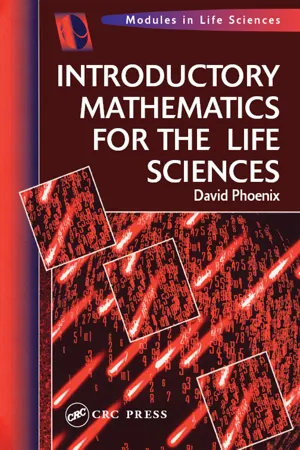
This is a test
- 229 pages
- English
- ePUB (mobile friendly)
- Available on iOS & Android
eBook - ePub
Introductory Mathematics for the Life Sciences
Book details
Book preview
Table of contents
Citations
About This Book
Introductory Mathematics for the Life Sciences offers a straightforward introduction to the mathematical principles needed for studies in the life sciences. Starting with the basics of numbers, fractions, ratios, and percentages, the author explains progressively more sophisticated concepts, from algebra, measurement, and scientific notation through the linear, power, exponential, and logarithmic functions to introductory statistics. Worked examples illustrate concepts, applications, and interpretations, and exercises at the end of each chapter help readers apply and practice the skills they develop. Answers to the exercises are posted at the end of the text.
Frequently asked questions
At the moment all of our mobile-responsive ePub books are available to download via the app. Most of our PDFs are also available to download and we're working on making the final remaining ones downloadable now. Learn more here.
Both plans give you full access to the library and all of Perlego’s features. The only differences are the price and subscription period: With the annual plan you’ll save around 30% compared to 12 months on the monthly plan.
We are an online textbook subscription service, where you can get access to an entire online library for less than the price of a single book per month. With over 1 million books across 1000+ topics, we’ve got you covered! Learn more here.
Look out for the read-aloud symbol on your next book to see if you can listen to it. The read-aloud tool reads text aloud for you, highlighting the text as it is being read. You can pause it, speed it up and slow it down. Learn more here.
Yes, you can access Introductory Mathematics for the Life Sciences by David Phoenix in PDF and/or ePUB format, as well as other popular books in Mathematics & Applied Mathematics. We have over one million books available in our catalogue for you to explore.
Information
1 | Numbers |
1.1 Introduction
Scientists must be able to take quantitative measurements and look for correlations within their experimental data. A scientist should therefore be able to manipulate numbers and have an appreciation of their relevance. The objectives of this chapter are:
(a) to introduce real numbers;
(b) to develop rules for the manipulation of numbers.
1.2 Real numbers
Real numbers may be represented by their position on a number line (Figure 1.1). All the numbers which lie on this line are termed real numbers and the set is represented by the symbol ℝ. Whole numbers (integers) are represented by the symbol ℤ and can be sub-grouped into positive (ℤ+) or negative (ℤ−) integers.
Negative numbers are written to the left of zero. The further a number is to the right, the bigger it is, so for example −2 is greater than −5. Addition therefore indicates that you move to the right, since the number is getting bigger; subtraction indicates that you move to the left.
On the number line, the further the number is to the right the bigger it is
Figure 1.1

ℝ represents the group of all numerical values which can be represented on the number line (i.e. the real numbers)
ℤ represents the set of intergers {…−3, −2, −1, 0, 1, 2, 3,…}
ℤ+ represents the set of positive integers, sometimes called natural numbers {1, 2, 3, 4,…}
ℤ− represents the negative integers {−1, −2, −3, −4,…}
It is obviously important that you are able to manipulate both positive and negative numbers. It is useful to remember that if you are adding a negative number to a positive number you can treat this as a subtraction, as shown in Example 1.1.
Example 1.1
It may help to remember the number line. In Example 1.1 you start at position minus two (−2) and plus three (+3) tells you to move to the right three places, which takes you to position one on the number line. In Example 1.2 you start at position minus four and move one pl...
Table of contents
- Cover
- Half Title
- Title Page
- Copyright Page
- Table of Contents
- General Preface to the Series
- Preface
- 1 Numbers
- 2 Fractions, Percentages and Ratios
- 3 Basic Algebra and Measurement
- 4 Powers and Scientific Notation
- 5 Concentration and Accuracy
- 6 Tables, Charts and Graphs
- 7 Linear Functions
- 8 Power Functions
- 9 Exponential Functions
- 10 Logarithmic Functions
- 11 Introduction to Statistics
- Appendix: Solutions to Problems
- Index